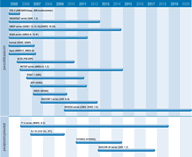Soil Moisture
Soil moisture plays a key role in the hydrological cycle. Evaporation rates, surface run-off, infiltration and percolation are all affected by the level of moisture in the soil. Soil moisture monitoring at scales from small catchments to large river basins is important for drought analysis, crop yield forecasting, irrigation planning, flood protection and forest fire protection. There is a pressing need for measurements of soil moisture for applications such as crop yield predictions, identification of potential famine areas, irrigation management, and monitoring of areas subject to erosion and desertification, and for the initialisation of NWP models.
Direct measurement of soil moisture from space is difficult. Most of the active and passive microwave instruments will provide some soil moisture information for regions of limited vegetation cover. However, under many conditions remote sensing data are inadequate, and information regarding moisture depth remains elusive. While recent studies have successfully demonstrated the use of infrared, passive microwave, and non-SAR sensors to obtain soil moisture information, the potential of active microwave remote sensing based on SAR instruments remains largely unrealised. The main advantage of radar is that it provides observations at a high spatial resolution of tens of metres compared to tens of kilometres for passive satellite instruments such as radiometers or non-SAR active instruments such as scatterometers. The main difficulty with SAR imagery is that soil moisture, surface roughness, and vegetation cover all have an important and nearly equal effect on radar backscatter. These interactions make retrieval of soil moisture possible only under particular conditions such as bare soil or surfaces with low vegetation or complex modelling to 'subtract' contributions/effects of vegetation.
An appropriate instrument for measurements of soil moisture would appear to be the passive microwave radiometer, although some success has been achieved by radar - despite the complications of analysing the signals reflected from the ground. Microwave radiation emitted at the ground can be monitored to infer estimates of soil moisture. Passive microwave sensors can be used to do this based on detection of surface microwave emissions, although the signal is very small. Reliable data (high signal to noise ratio) need to be taken over a large area - which introduces the problem of understanding how to interpret the satellite signal since it consists of reflected radiation from many different soil types.
SAR data currently provide the main source of information on near-surface (10-15cm) soil moisture - for example ASAR on ESA’s Envisat mission provides data from which soil moisture information can be inferred, and a project using ASAR data is planned to produce maps of seasonal soil moisture patterns at the regional scale for two European river basins.
AMSR-E on Aqua provides a variety of information on water content by measuring weak radiation from the Earth’s surface. NOAA’s conical microwave imager/sounder, CMIS, will provide environmental data including indications of soil moisture.
The first mission likely to satisfy requirements for observing soil moisture from space for the primary applications of hydrologic and meteorological models will be ESA’s SMOS (Soil Moisture and Ocean Salinity Mission), carrying the MIRAS (Microwave Imaging Radiometer using Aperture Synthesis) passive L-band 2-D interferometer (from 2007). The approval of the NASA HYDROS mission for soil moisture measurement (launch date around 2010) will allow cross-comparison of results.

